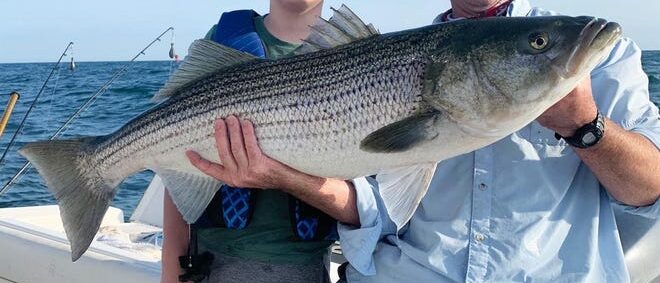Say hello to the largest member of the sea bass family – Striped Bass, one of the most popular game fish that can be found both in fresh and salt waters of the USA. The striped bass is also known as Atlantic striped bass, striper, linesider, rock or rockfish. It can live both in fresh water and salt water and can be found primarily along the Atlantic coast of North America.

You don’t believe how popular striper is? It is the fourth most preferred species among licensed Texas anglers. It is estimated that the economic impact of striped bass fishing in the Lake Texoma area alone totals well in excess of $20 million. Amazing, isn’t it!
But let’s see something more about this amazing fish!
Where to Find Striped Bass?
Striper has been widely introduced into inland recreational fisheries across the United States. Striper found in the Gulf of Mexico are a separate strain referred to as Gulf Coast striper. The striped bass is the state fish of Rhode Island, Maryland, and South Carolina, and the state saltwater fish of New York, Virginia, New Jersey, and New Hampshire.
Striped bass are native to North America’s Atlantic coastline from the St. Lawrence River into the Gulf of Mexico to Louisiana. They are so-called anadromous fish that migrate between fresh and saltwater where they spawn.
Four important bodies of water with striped bass are the Chesapeake Bay, Massachusetts Bay/Cape Cod, Hudson River, and Delaware River
How long do Striped Bass Live?
Striped bass live from 10 to 30 years. The common mature size is 20 to 40 pounds. The average size in length is 20 to 35 inches and approximately 5 to 20 pounds.
What Is The Biggest Striped Bass Ever Caught?
The largest striper recorded was 124 pounds (56 kg), netted in 1896. But the largest striper ever taken by angling was an 81.88-lb (37.14-kg) taken from a boat in Long Island Sound, near the Outer Southwest Reef. The all-tackle world record fish was taken by Gregory Myerson in 2011. The fish took a drifted live eel bait, and fought for 20 minutes before being boated. The fish measured 54″ in length with a girth of 36″.
What Do Striped Bass Eat?
Adults primarily eat fish, feeding predominantly on members of the herring family such as gizzard shad and threadfin shad.
Striped Bass Spawn
In coastal populations, striper may ascend streams and travel as much as 100 miles inland to spawn. Spawning begins in spring when water temperatures approach 60°F – spawning period usually extends from April to mid-June. One female is usually accompanied by several males during the spawning act. Running water is absolutely necessary to keep eggs in motion until hatching. Generally, at least 50 miles of the stream is required for successful hatches. Eggs hatch in two to three days and after that larvae move slowly downstream. Throughout the summer, juveniles live in the shallows of tidal rivers. Most of them spend their first two years of life in the river in which they were born.
The Bay is the largest striper nursery area on the Atlantic coast. 70 to 90 percent of the Atlantic striped bass population uses the Bay to spawn.
How to Catch Striper?
Striped bass are valuable for sport fishing, and have been introduced to many waterways outside their natural range. Anglers use a variety of methods, including trolling and surf casting with topwater lures a good pick for surf casting, as well as bait casting with live and dead bait. Striper will take a number of live and fresh baits, including bunker, eels, clams, sandworms, bloodworms, herring, mackerel, and shad, bluegills, worms, crayfish, bucktails jigs, and silver spoons.
Striped bass angling is done through the whole year, but fishing localities vary seasonally in accordance with the striped bass migratory pattern. In wintertime, striped bass are spread from San Francisco Bay throughout the Delta and fishing is generally poor because stripers do not feed actively when the water is cold, while rivers are great places to fish for striped bass in the spring.
Striped bass can be caught either by bait fishing or trolling. It is advisable to use hooks at least half an inch between the point and the shank in order to avoid catching too many undersized stripers. When talking about successful bait fishing, it is generally necessary to keep the bait near the bottom. Strong tidal currents are mostly present on striped bass fishing grounds. It is particularly important to have a varied assortment of sinkers, so that the amount of weight can be adjusted to match the changing strength of the current.
Best Striped Bass Tackle
Generally a heavy tackle is necessary for charter boat fishing to prevent undue fouling of lines and in some types of deep-water fishing involving the use of heavy sinkers.
What are the Best Striped Bass Baits?
Threadfin shad are probably the most common bait in the Delta. The shad are usually split and placed on the hook, folded with the flesh side out. In the Delta, sardines, bloodworms, anchovies, and pile worms are also popular baits. Drift fishing with live bait (mostly shiner perch or anchovies) is popular in the San Francisco Bay area. Sculpins and oriental gobies are frequently used in San Pablo and Suisun bays, either alive or dead.
Striped Bass Fishing Lures
Many types of jigs, plugs, and spoons are used in trolling, frequently in double combinations.
Fly Fishing For Striped Bass
Striped bass are the Northeast coast angler’s most popular target for fly fishing. If you seek trophy stripers, think big. That fish couldn’t be caught on lighter tackle, but consider 10, 11, even 12-weight rods when you target the largest fish. Your reel should definitely start up and give up line smoothly, and hold 150 yards of stout dacron or gel spun backing.

